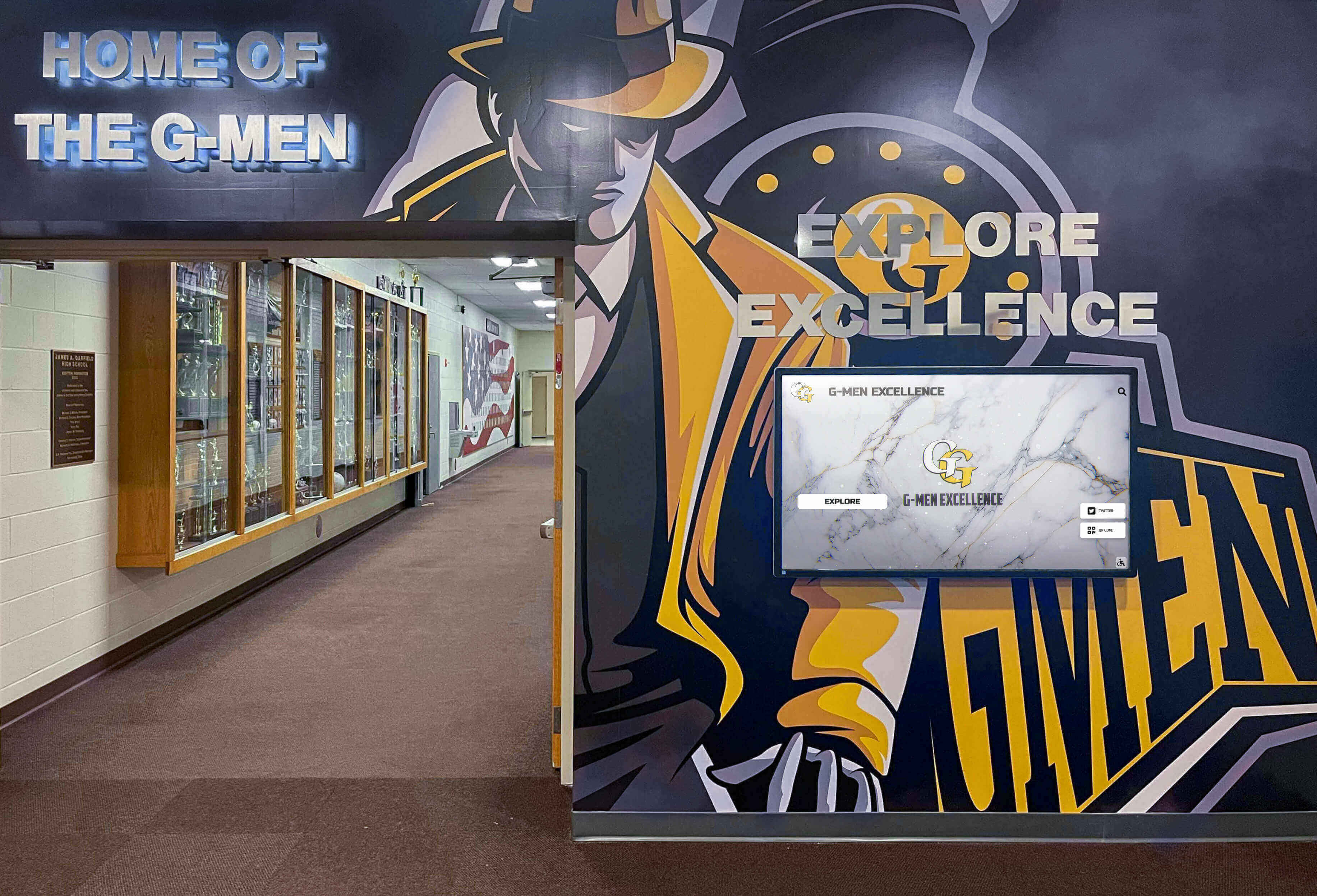Key Takeaways
Complete guide to showcasing school board members on touch TV displays. Learn how interactive digital recognition enhances transparency, builds community connections, and honors dedicated school leadership through modern touchscreen technology.
Why School Board Recognition Matters for Educational Communities
Visible, accessible school board recognition delivers significant benefits that extend throughout educational communities, strengthening governance, engagement, and public understanding of institutional leadership.
Enhancing Transparency and Accessibility
Educational governance thrives when community members understand who makes decisions affecting their schools. Traditional approaches to board member visibility—small photos on obscure website pages or aging hallway displays—create barriers preventing meaningful connections between leadership and constituents.
Interactive digital displays positioned in high-traffic school locations make board member information immediately accessible to everyone visiting buildings. Parents dropping off children, students passing through lobbies, community members attending events, and prospective families touring facilities all encounter prominent board recognition showcasing who leads their schools. This visibility fundamentally changes the relationship between governing boards and the communities they serve.
When board member profiles include professional backgrounds, educational expertise, committee assignments, contact information, and years of service, community members gain context for understanding leadership composition and qualifications. Parents discover which board members bring education experience, business acumen, legal expertise, or specific community perspectives to decision-making processes. This transparency builds confidence that diverse expertise guides institutional direction.

Demonstrating Appreciation for Volunteer Service
School board membership demands extraordinary time commitments—evening meetings, committee work, strategic planning sessions, community events, professional development, and constituent communications that can total 10-20 hours weekly or more. These volunteers balance board responsibilities with careers, families, and other commitments, making significant personal sacrifices to serve their educational communities.
Public recognition validates this dedication while demonstrating that districts value volunteer governance. When board members see their service honored through professional displays featuring biographical profiles, accomplishments, and contributions, it reinforces that communities appreciate their leadership. This appreciation supports board member retention while making board service more attractive to potential future candidates who observe how institutions honor current leaders.
Recognition also educates communities about the scope and complexity of board responsibilities. Many constituents underestimate what board service entails, viewing meetings as the only commitment. Comprehensive profiles highlighting committee work, community engagement, professional development, and years of service build understanding of the substantial dedication effective board governance requires.
Building Connections Between Leadership and Community
School boards make better decisions when they understand community needs, perspectives, and priorities. Similarly, communities support educational initiatives more effectively when they understand board member backgrounds, expertise, and decision-making rationale. Recognition displays that make board members visible and accessible strengthen these essential connections.
Interactive displays can include information about each board member’s connection to the district—whether they’re alumni, parents of current or former students, long-time community residents, or professionals with relevant expertise. These personal connections help constituents identify board members who share their experiences or perspectives, making leadership feel more relatable and accessible.
Contact information inclusion enables direct constituent communication. When community members can easily identify which board member represents their area or has expertise relevant to their concerns, they’re more likely to engage constructively with governance processes. This accessibility transforms boards from distant authorities into approachable community representatives.
Understanding Different Approaches to School Board Display
Schools implement board member recognition through various formats, each offering distinct advantages based on institutional needs, budgets, available space, and communication objectives.
Traditional Physical Board Displays
Conventional school board recognition typically employs physical approaches—framed photographs on hallway walls, dedicated display cases in main lobbies, or recognition boards near administrative offices showing board member names and photos.
Advantages of Traditional Displays:
- Simple, familiar format requiring no technology infrastructure
- One-time installation costs without ongoing subscription fees
- Physical presence creating permanent visible commitment
- No concerns about technology failures or outdated software
- Straightforward updates through photograph replacement
Limitations of Physical Approaches:
- Minimal information capacity beyond names, photos, and basic titles
- Difficult and expensive updates when board membership changes
- No ability to include video messages, meeting schedules, or dynamic content
- Limited accessibility for vision-impaired community members
- No analytics about how many people view displays or engage with information
- Space constraints limiting how much context can be provided
Many schools maintain traditional displays for years but eventually confront their limitations when communities seek more substantial information about board members’ backgrounds, expertise, committee roles, and ways to communicate with leadership.
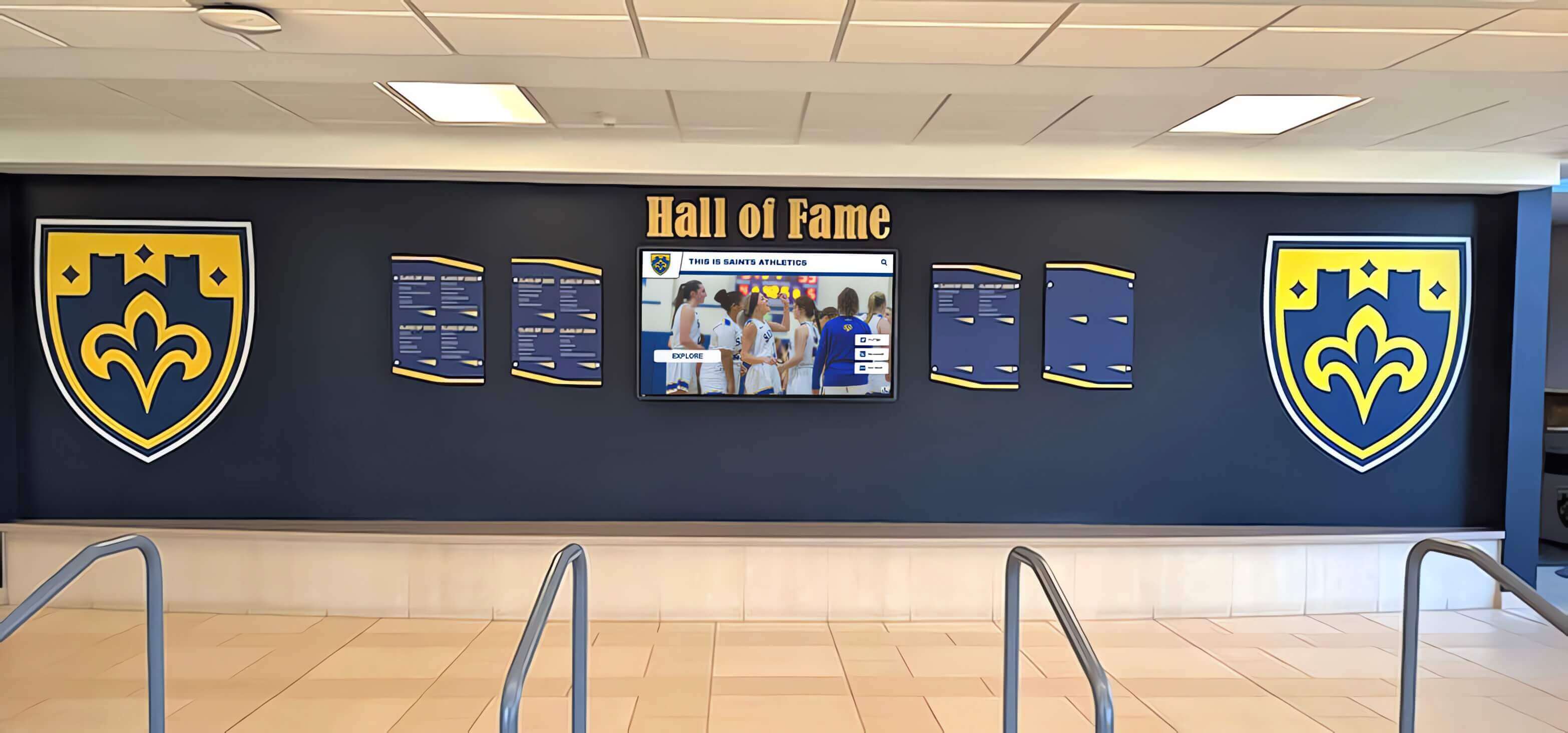
Interactive Touchscreen Displays for Board Recognition
Modern touch TV systems transform school board recognition through unlimited content capacity, rich multimedia presentations, and interactive exploration that traditional displays cannot provide.
Comprehensive Board Member Profiles: Digital platforms enable complete leadership biographies including professional backgrounds and relevant expertise, educational credentials and experience, years of service and board leadership roles, committee assignments and specific responsibilities, community connections and personal ties to the district, accomplishments and contributions during tenure, contact information and communication preferences, video introductions allowing board members to speak directly to constituents, and links to relevant meeting materials and governance documents.
Interactive Exploration Features: Visitors actively engage with board information through searchable databases allowing name-based finding, filtering options by committee, experience, or tenure, meeting calendar integration showing upcoming sessions, document access to agendas, minutes, and policy materials, video archives of board meeting highlights or messages, and connection to broader school information about leadership and governance.
Real-Time Updates and Current Information: Cloud-based content management allows instant updates when board membership changes, immediate corrections if contact information or committee assignments shift, scheduled content displaying upcoming meetings or board priorities, seasonal messages from board leadership about strategic initiatives, and emergency communications during critical situations requiring community awareness.
Solutions like digital recognition displays designed for educational institutions provide comprehensive platforms specifically optimized for school board visibility and community engagement.
Website Integration and Multi-Platform Approaches
Many schools implement hybrid strategies combining physical touchscreen displays in buildings with comprehensive web-based board information accessible remotely, offering advantages of both approaches while addressing respective limitations.
Physical Display Benefits: Capture attention from all building visitors regardless of whether they regularly check websites, provide visible commitment to transparency positioned prominently in facilities, offer interactive engagement drawing people into deeper exploration, and serve constituents who may not regularly access online resources but visit buildings frequently.
Website Complement: Extend access to board information beyond physical building visits, enable 24/7 constituent access from home, work, or mobile devices, provide searchable archives of meeting materials and historical information, accommodate detailed content that may overwhelm physical displays, and support sharing via social media or email when community members want to reference specific board information.
This multi-platform approach maximizes board visibility and accessibility by meeting community members where they already engage—both in school buildings and through digital channels they access daily.
Essential Content for School Board Recognition Displays
Meaningful board recognition extends far beyond names and photographs. Comprehensive profiles celebrate board members’ expertise, service, and leadership while educating communities about governance structures and decision-making processes.
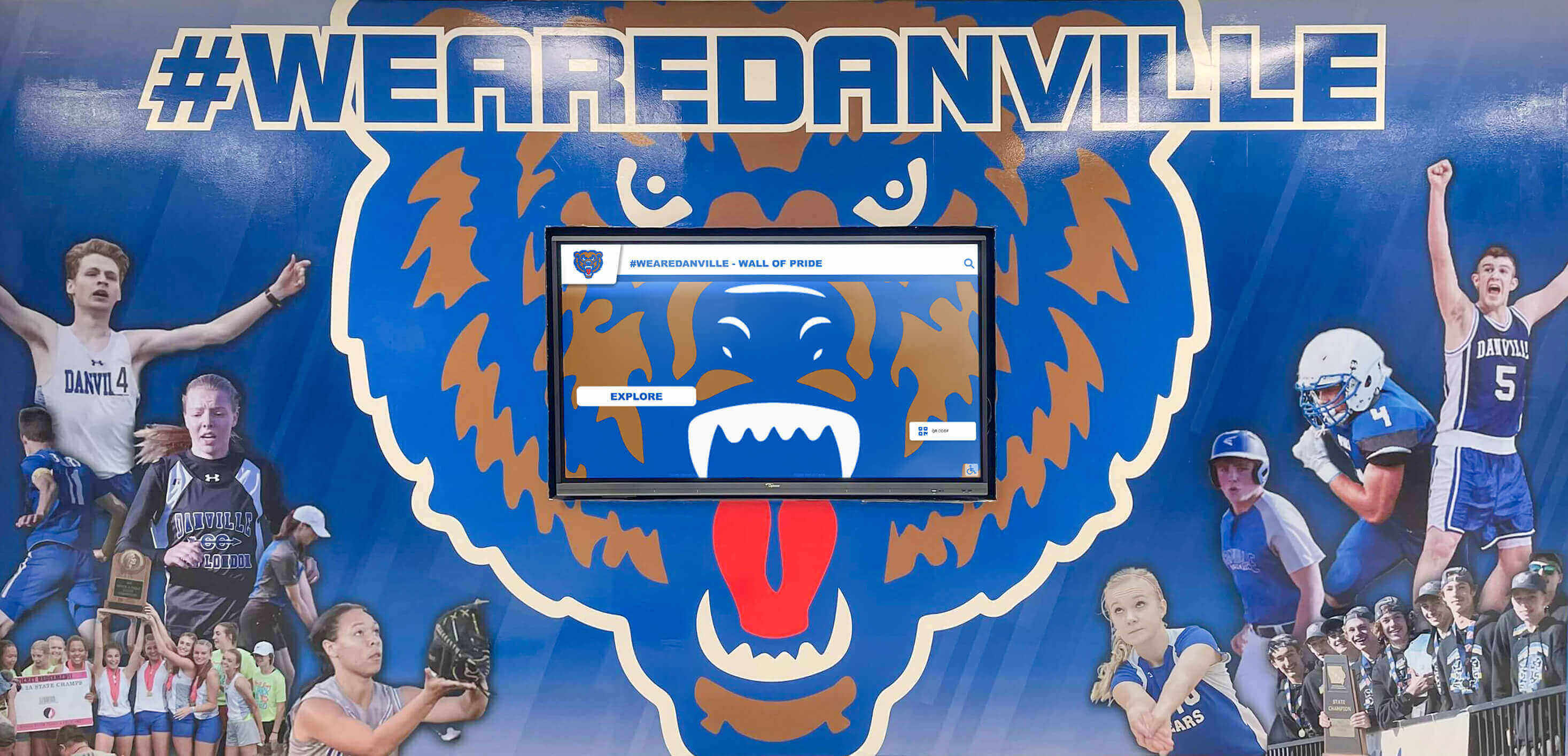
Professional and Educational Background
Career Experience: Present board members’ professional backgrounds highlighting expertise relevant to educational governance including business and financial management experience, legal background supporting policy development, educational experience as teachers or administrators, healthcare expertise informing student wellness initiatives, technology backgrounds guiding digital transformation, and community leadership in other organizations demonstrating governance capabilities.
Educational Credentials: Document board members’ academic backgrounds including degree fields and institutions, professional certifications relevant to education or governance, continuing education in school leadership or policy, and specialized training in board development or educational law.
Relevant Expertise: Highlight specific knowledge areas board members contribute including budget development and financial oversight experience, curriculum and instruction expertise, facilities planning and construction management, special education law and student services, athletics and extracurricular program knowledge, and human resources and labor relations understanding.
Personal Connection to the District
Community Ties: Showcase why board members chose to serve through personal district history as alumni, current or former parent status, years as community resident, multigenerational family connections to schools, and professional ties to local organizations partnering with districts.
Motivations for Service: Include board members’ own words about why they serve, what they hope to accomplish during their tenure, which aspects of education matter most to them personally, how their experiences inform their governance perspective, and what they find most rewarding about board service.
Community Involvement: Document broader community engagement beyond board service including volunteer activities in schools or educational programs, participation in community organizations and initiatives, coaching or mentoring roles with youth, and business or professional community contributions.
Board Service Details and Governance Information
Tenure and Leadership Roles: Clearly present years of service and term expiration dates, board officer positions held (president, vice president, secretary), committee chairs and membership, historical service on previous boards or committees, and special assignments or task force participation.
Committee Assignments: Detail specific governance responsibilities including finance committee oversight of budgets and expenditures, curriculum and instruction committee guiding academic programs, facilities committee overseeing buildings and maintenance, policy committee reviewing and recommending governance policies, personnel committee addressing staffing and labor relations, and ad hoc committees formed for specific projects or initiatives.
Representation Areas: For districts with geographic representation, clarify which areas or regions each board member represents, how constituents can identify their representative, and what geographic boundaries define representation.
Systems designed for teaching recognition and educational leadership display provide templates ensuring consistent, professional board member presentation across all profiles.
Contact Information and Constituent Communication
Multiple Communication Channels: Provide various options for constituent contact including email addresses monitored by board members, phone numbers (personal or district-provided contact lines), office hours or scheduled availability for constituent meetings, and social media profiles when board members maintain public accounts for governance communication.
Communication Preferences: Set appropriate expectations by clarifying preferred contact methods for different types of inquiries, typical response timeframes for constituent communications, guidelines for emergency versus routine contact, and whether board members prefer direct contact or communication through district administration.
Meeting Attendance Information: Enable community participation by displaying regular meeting schedules and locations, committee meeting times open to public attendance, public comment procedures and sign-up processes, meeting agenda publication schedules, and links to meeting materials and supporting documents.
Accomplishments and Contributions During Service
Major Initiatives: Highlight significant achievements during board tenure including facility improvements or construction projects approved and completed, curriculum enhancements or program additions implemented, technology initiatives expanding student and staff capabilities, financial strategies improving district fiscal health, and policy changes addressing community needs or regulatory requirements.
Strategic Planning Participation: Document involvement in long-range institutional planning including visioning processes guiding district direction, strategic plan development and goal-setting, community engagement in planning initiatives, and monitoring of progress toward strategic objectives.
Recognition and Leadership: Acknowledge external recognition of board service including state board association awards or recognition, leadership roles in regional or state governance organizations, professional development completed in school governance, and community awards for public service beyond board role.
Planning and Implementing School Board Touch TV Displays
Successful implementation requires systematic planning addressing technology selection, content development, placement strategy, community engagement, and sustainable maintenance processes.
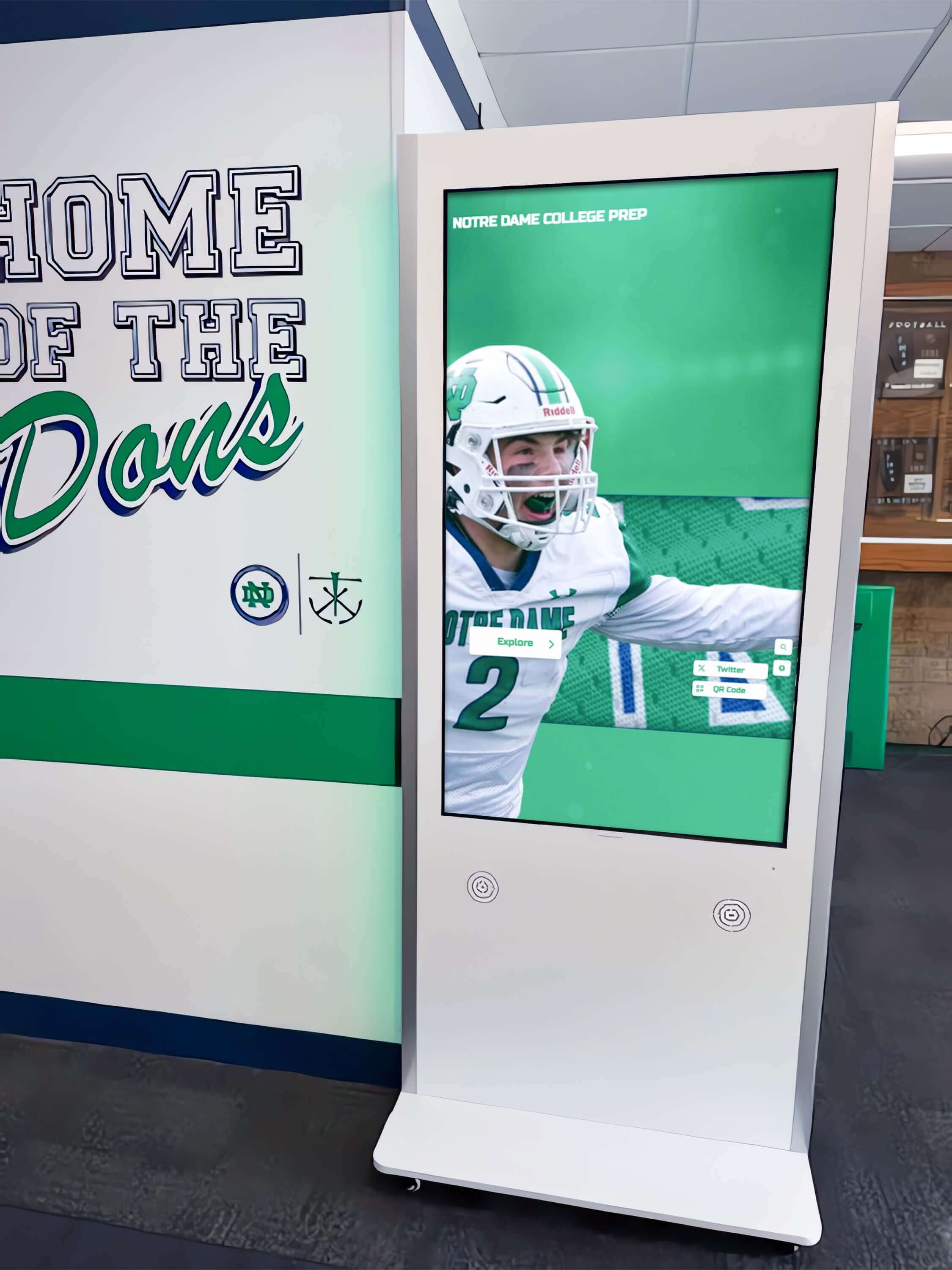
Assessment and Strategic Planning
Defining Objectives: Begin by clarifying what the board display should accomplish—whether primarily enhancing transparency and accessibility, building community connections with leadership, educating constituents about governance structures and processes, honoring volunteer service and time commitment, supporting recruitment of future qualified board candidates, or demonstrating commitment to open, accessible governance.
Audience Identification: Consider who will primarily interact with displays and what information matters most to different audiences. Parents may prioritize understanding which board members share their concerns or represent their areas. Students might appreciate seeing board members’ personal connections to schools. Staff members value knowing governance priorities and decision-making processes. Community members want to understand who leads their educational institutions and why these individuals are qualified.
Location Strategy: Identify optimal placement in high-traffic areas maximizing visibility. Main building entrances capture all visitors establishing immediate transparency. Administrative office lobbies serve families with business at district offices. School board meeting rooms educate meeting attendees about members. Athletic facility entrances engage sports families attending events. Multiple locations serve different constituent groups where they naturally gather.
Technology Selection and Procurement
Display Hardware Considerations: Select commercial-grade touchscreens rated for continuous operation in public settings. Screen sizes typically range from 43-65 inches depending on viewing distance and content density. Consider whether wall-mounted installations or freestanding kiosks better suit available space. Ensure touchscreen technology provides responsive, intuitive interaction. Verify display brightness accommodates ambient lighting conditions in planned locations.
Software Platform Requirements: Evaluate content management systems designed for educational recognition and communication. Confirm multimedia support for photos, videos, and documents. Verify search and filtering capabilities for board member exploration. Ensure web accessibility features support vision-impaired visitors. Evaluate analytics capabilities tracking engagement and usage. Check for mobile-responsive web platform complementing physical displays.
Installation Planning: Assess mounting requirements and wall structural capacity. Verify power and network infrastructure availability. Consider security and vandalism protection in accessible areas. Ensure ADA compliance for mounting height and interaction. Plan cable management maintaining professional appearance.
Professional Services: Engage experienced installers familiar with educational environments. Confirm proper electrical connections meeting codes. Implement secure mounting preventing theft or damage. Test all features thoroughly before launch. Document system specifications and operating procedures.
Resources about implementing digital recognition displays in educational settings provide technical guidance for selection and installation processes.
Content Development and Board Member Engagement
Information Gathering Process: Coordinate with board members and district administration to systematically collect professional biographies highlighting relevant expertise, high-resolution professional photographs, educational backgrounds and credentials, committee assignments and governance responsibilities, contact preferences and constituent communication guidance, personal statements about motivation for service, and video introductions if board members are willing to record brief messages.
Photography Standards: Maintain consistent professional appearance through similar background settings, consistent lighting and composition, appropriate attire reflecting board member role, current photos taken within the past year, and high-resolution images suitable for large display presentation.
Privacy and Accuracy: Respect board member privacy preferences regarding personal information disclosure, particularly home addresses or personal phone numbers. Verify all content accuracy before publication including names, titles, and credentials. Establish review processes where board members confirm their profiles before going live. Create clear policies about what information displays publicly versus remains available through other channels.
Ongoing Update Processes: Establish clear responsibility for maintaining current information. Designate staff members authorized to update content. Create workflows for new board member onboarding including timely profile creation. Schedule annual profile reviews ensuring information remains accurate. Implement immediate update procedures when board leadership roles or committee assignments change.
Launch Strategy and Community Engagement
Soft Launch Testing: Conduct limited initial rollout to identify technical issues, usability problems, or content errors before full public debut. Test with board members, administrative staff, and selected community representatives. Verify search functionality with actual board member names. Confirm all multimedia elements display correctly. Ensure navigation flows intuitively for users unfamiliar with the system.
Official Unveiling: Plan formal launch during board meeting or community event when visibility runs high. Demonstrate interactive features helping visitors understand capabilities. Invite media coverage promoting transparency and community connection. Communicate launch through multiple channels including district newsletters, social media, website announcements, and school communications to families.
Educational Support: Provide brief instructions or video tutorials demonstrating how to use interactive features. Train front office staff to direct visitors to displays. Prepare talking points helping board members discuss displays with constituents. Create FAQ materials addressing common questions about board governance and member responsibilities.
Feedback Collection: Establish channels for ongoing community input about display usefulness and improvement opportunities. Simple feedback forms near displays invite suggestions. Online survey links gather broader community perspectives. Board meeting public comments may surface reactions. Regular feedback review identifies opportunities for content additions, feature enhancements, and usability improvements.
Maximizing Long-Term Value and Community Engagement
Initial implementation represents just the beginning. Sustained value requires ongoing content maintenance, strategic enhancements, and integration with broader community communication.
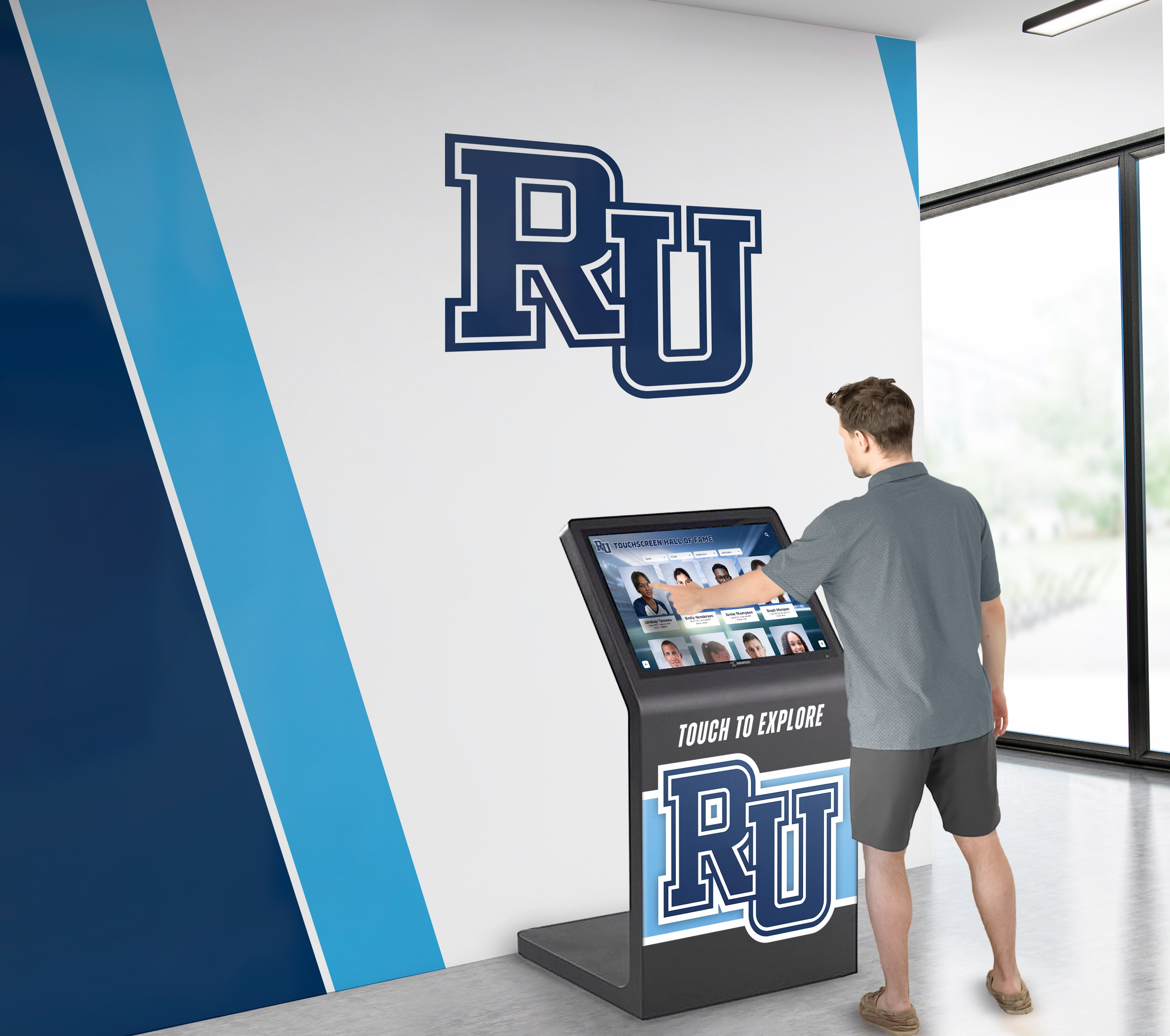
Content Currency and Relevance
Continuous Updates: Maintain display credibility through immediate updates when board membership changes, prompt corrections when contact information or committee assignments shift, regular refreshes of meeting schedules and upcoming governance activities, periodic photo updates ensuring current appearance, and timely addition of accomplishments and recognitions as they occur.
Seasonal Content Enhancements: Keep displays engaging through strategic planning season highlights showcasing board priorities, budget development period education about fiscal oversight, back-to-school messages from board leadership, graduation season reflections on student success, and recognition of board member milestones like service anniversaries.
Meeting Integration: Strengthen connection between displays and governance processes by displaying upcoming meeting agendas and times prominently, linking to streaming or recorded meeting videos, highlighting recent board decisions affecting community, featuring board president messages about current priorities, and providing easy access to meeting materials and supporting documents.
Systems designed for comprehensive community recognition and engagement enable efficient content management ensuring board displays remain current and relevant.
Analytics and Continuous Improvement
Engagement Monitoring: Modern platforms provide usage data informing content strategy including total interaction counts and traffic patterns, average time visitors spend exploring board information, most-viewed board member profiles, search terms revealing constituent interests, and peak usage times suggesting optimal content refresh scheduling.
Content Optimization: Apply insights from analytics to enhance display effectiveness by expanding information about board members generating highest interest, improving navigation for frequently searched information, creating more content in formats proving most engaging, addressing content gaps revealed by search behavior, and testing different approaches to present complex governance information accessibly.
Constituent Feedback Integration: Systematically incorporate community suggestions by reviewing feedback quarterly identifying themes, implementing improvements addressing common requests, communicating changes back to community members who provided input, and continuously refining based on actual usage patterns rather than assumptions about what constituents need.
Integration with Broader Community Communication
Website Coordination: Ensure consistency between physical displays and web-based information with synchronized content across platforms, mobile-responsive web pages mirroring display information, deep linking from displays to detailed web content, and social sharing enabling easy constituent reference to specific board information.
Social Media Connection: Amplify board visibility through digital channels by sharing board member spotlights on district social accounts, promoting upcoming board meetings and important decisions, celebrating board member service milestones and accomplishments, and encouraging community members to explore board displays when visiting buildings.
Newsletter and Publication Integration: Feature board recognition in broader district communications including board member profiles in newsletters and publications, highlights of governance decisions and rationale, invitations to board meetings and committee sessions, and recognition of board service during appreciation events.
Recruitment and Succession Planning: Leverage board displays for governance sustainability by showcasing the value and impact of board service, demonstrating diversity of expertise and perspectives needed, explaining board member responsibilities and time commitments, providing information about candidate qualifications and election processes, and inspiring community members to consider future board service.
Addressing Common Implementation Challenges
Schools frequently encounter predictable obstacles when implementing board recognition displays. Understanding these challenges enables proactive solutions ensuring successful, sustainable implementations.
Challenge: Board Member Privacy Concerns
Some board members may hesitate about public display of personal information, contact details, or professional backgrounds they consider private.
Balanced Approaches: Establish clear policies distinguishing between information appropriate for public display and details available through other channels. Respect individual board member preferences about contact information disclosure while maintaining reasonable transparency. Provide district email addresses or phone lines if members prefer not to share personal contact information. Focus profiles on governance-relevant information while respecting reasonable privacy boundaries. Emphasize that increased visibility serves communities while making board service more attractive to potential future candidates.
Challenge: Maintaining Content Currency During Board Turnover
Board elections, resignations, or appointments create regular content update requirements that can be overlooked during busy transition periods.
Systematic Processes: Implement formal onboarding procedures for new board members including photography session scheduling, biographical information collection, profile development and review, and display update deadlines ensuring new members appear promptly. Create off-boarding workflows removing or archiving outgoing board member information appropriately. Maintain content calendar tracking term expiration dates and election cycles. Designate clear responsibility for update execution preventing delays.
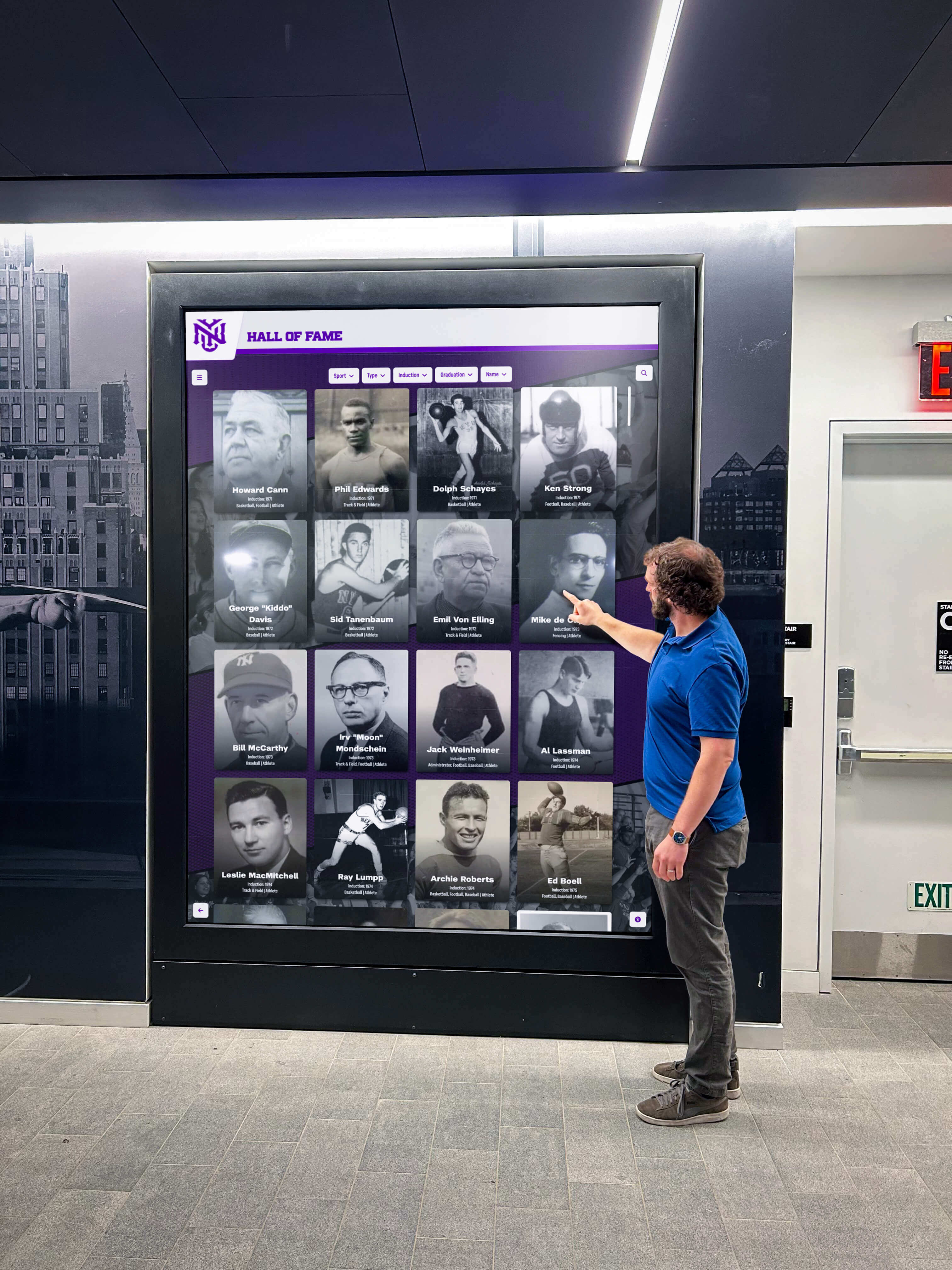
Challenge: Balancing Comprehensive Information with Readability
Detailed board member profiles risk becoming overwhelming, while minimal information provides insufficient community understanding.
Layered Information Architecture: Design content hierarchy revealing information progressively. Display overview cards showing photo, name, position, and key contact information. Allow visitors to tap for expanded profiles with biographical details and expertise. Provide additional tabs or links to committee information, meeting schedules, and governance resources. This layered approach accommodates varying constituent needs—some seeking quick contact information, others desiring comprehensive background understanding.
Challenge: Technical Support and Troubleshooting
Hardware failures, software glitches, or connectivity issues can disrupt display functionality undermining community trust in district technology capabilities.
Support Infrastructure: Establish clear technical support responsibility including staff authorized to troubleshoot basic issues, vendor contact information and support procedures for complex problems, regular preventive maintenance checking for potential failures, and contingency plans if displays become temporarily non-functional. Consider service contracts providing guaranteed response times. Train multiple staff members on basic troubleshooting preventing single-person dependencies.
Challenge: Measuring Impact and Return on Investment
Administrators and board members may question whether display investments deliver sufficient value justifying costs, particularly in budget-constrained environments.
Multi-Dimensional Assessment: Evaluate impact through multiple lenses including engagement metrics from display analytics, constituent feedback through surveys and public comments, community awareness measured through periodic polling, recruitment indicators like candidate quality and quantity for board openings, and qualitative observations about community-board relationship changes. Connect displays to broader strategic objectives around transparency, engagement, and community connection rather than viewing them as isolated technology investments.
The Future of School Board Communication and Recognition
School board service represents essential community contribution deserving visibility matching the significance of governance responsibilities. These dedicated volunteers shape educational direction, oversee substantial budgets, develop policies affecting thousands of students and families, and provide strategic leadership guiding institutions through complex challenges.
Yet traditional approaches to board recognition often leave these leaders invisible to the communities they serve—relegated to aging photographs, obscure website pages, or minimal recognition that fails to convey the expertise, dedication, and time commitment effective governance requires. This visibility gap undermines transparency, limits constituent connections with leadership, and makes board service less attractive to qualified potential future candidates.
Modern touchscreen technology transforms school board recognition from basic identification to comprehensive community resource. Interactive displays positioned prominently in school buildings make board members immediately accessible to all visitors. Rich profiles showcasing professional expertise, personal connections to districts, governance responsibilities, and contact information build understanding and facilitate constituent communication. Video messages from board members create personal connections traditional static displays never achieve. Integration with meeting schedules, agendas, and governance documents transforms displays into comprehensive board information portals.
Whether implementing standalone board recognition displays or integrating board profiles within broader digital recognition systems celebrating educational achievement, modern platforms provide capabilities ensuring school board members receive visibility matching their contributions’ significance.
Ready to create an engaging school board recognition display? Rocket Alumni Solutions provides purpose-built platforms specifically designed for educational recognition and communication, combining intuitive content management with powerful interactive presentation ensuring every board member receives professional recognition while strengthening transparency and community connections essential for effective educational governance.
